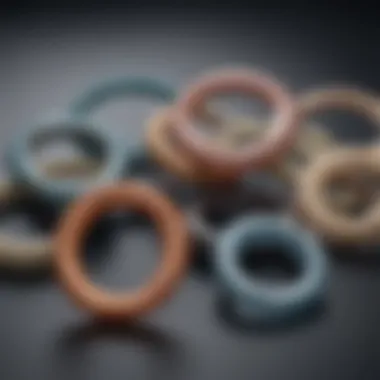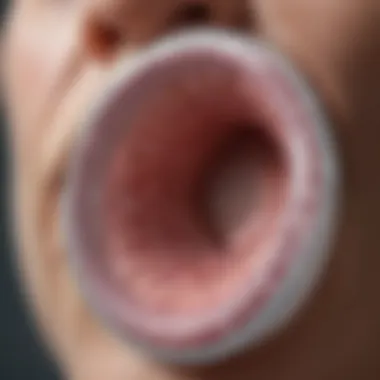Pessary Rings: A Solution for Stress Incontinence


Intro
Stress incontinence affects many individuals, leading to significant physical and emotional burdens. One of the therapeutic options available is the pessary ring. These devices offer a non-surgical approach to manage this common condition. This article aims to provide a comprehensive understanding of pessary rings, including their types, effectiveness, and patient-centered considerations, for healthcare professionals, patients, and researchers.
Key Findings
Major Results
Recent studies indicate that pessary rings are effective in reducing symptoms of stress incontinence. They can provide immediate relief, especially for women who may not desire surgery or cannot undergo surgical interventions due to other health issues. Research shows that with proper fitting and follow-up care, pessaries can lead to high rates of patient satisfaction and improvement in quality of life.
Discussion of Findings
The mechanism of action of pessary rings involves physical support to the pelvic floor and bladder. This translational support aims to minimize involuntary leakage during activities like coughing or exercising. However, individual responses to pessary use can vary. Factors such as the type of pessary selected, the fit, and adherence to follow-up care can all impact outcomes. Among the types of pessaries available, such as the ring pessary and the Gellhorn pessary, variations exist in design and indication, necessitating careful consideration during selection.
Methodology
Research Design
The findings summarized herein derive from a multitude of clinical trials, systematic reviews, and meta-analyses focusing on the efficacy and safety of pessary rings for stress incontinence. The research design predominantly involves longitudinal studies that assess patient outcomes over time, often employing randomized controlled trials to yield high-quality evidence.
Data Collection Methods
Data was collected through various means, including patient surveys, clinical assessments, and follow-up interviews. These methods foster comprehensive insights into patient experiences with pessary rings, including satisfaction levels, symptom relief, and any observed complications. The feedback gathered provides valuable information for ongoing improvements in clinical practice.
"Pessary rings are a viable alternative for those seeking non-surgical options in managing stress incontinence, and evidence supports their efficacy when properly fitted."
Prelude to Stress Incontinence
Stress incontinence is a significant health concern for many individuals, especially women. This condition involves the involuntary loss of urine during activities that increase intra-abdominal pressure, such as coughing, sneezing, or exercise. Understanding stress incontinence is crucial, as it not only affects physical health but also has social and psychological implications. Patients often experience a decline in quality of life due to the embarrassment associated with the condition.
Definition of Stress Incontinence
Stress incontinence can be defined as the unintentional leakage of urine that occurs with activities that put pressure on the bladder. This includes physical movements like jumping or lifting. It is important to differentiate stress incontinence from other types, such as urge incontinence, which is characterized by a sudden urge to urinate followed by involuntary leakage.
Prevalence and Impact
The prevalence of stress incontinence is notably high, particularly among women who have given birth or those who are older. Studies estimate that approximately 25-45% of women experience this condition at some point in their lives. This widespread nature highlights the necessity for effective treatment options and education. The impact of stress incontinence goes beyond physical symptoms; it can lead to emotional distress, social withdrawal, and can significantly hinder daily activities and overall well-being.
Contributing Factors
Several factors can contribute to the development of stress incontinence. They include:
- Age: The risk of stress incontinence increases as one ages.
- Pregnancy and childbirth: These can weaken pelvic floor muscles.
- Menopause: Hormonal changes during menopause can lead to changes in the urinary tract.
- Obesity: Extra weight places additional stress on the bladder.
- Genetics: A family history of urinary incontinence can increase risk.
- Certain surgeries: Procedures such as hysterectomy can affect pelvic support.
Understanding these contributing factors is essential for both prevention and treatment planning. By addressing these issues, healthcare providers can better support individuals suffering from stress incontinence.
Understanding Pessary Rings
The exploration of pessary rings is essential for comprehending their role in managing stress incontinence. Stress incontinence can significantly impact the quality of life for many individuals. Pessary rings offer a non-surgical and effective solution. They alleviate symptoms by providing support to the pelvic floor and urinary structures, which can result in increased confidence and reduced anxiety related to incontinence.
What is a Pessary Ring?


A pessary ring is a device designed to provide support to the pelvic region. It is typically made from medical-grade materials that can endure daily use. Pessary rings are inserted into the vagina and work by holding the urethra in place, thus reducing involuntary leakage of urine during physical activities. They are available in various sizes and shapes to cater to different anatomical needs.
Mechanism of Action
The mechanism by which pessary rings function is quite straightforward. Upon insertion, the ring exerts pressure on the anterior vaginal wall. This pressure creates a stabilizing effect on the bladder and surrounding tissues. The result is a decrease in the movement of the urethra, significantly lowering the likelihood of leaks during activities that increase abdominal pressure, such as coughing or exercising. This mechanism ties directly into the objective of providing a non-invasive approach to managing stress incontinence.
Types of Pessary Rings
The diversity of pessary rings enhances their adaptability to individual needs. Here, we discuss three specific aspects: Support Pessaries, Shape and Size Variations, and Materials Used.
Support Pessaries
Support pessaries are particularly designed to offer structural support. They hold pelvic organs and provide necessary reinforcement to the vaginal walls. This characteristic makes them a preferred choice for many healthcare providers and patients alike. Their adaptability is one reason they are extensively discussed in relation to stress incontinence.
Advantages of support pessaries include their ability to be fitted during a routine check-up, meaning that adjustments can be made easily based on the patient's needs. However, discomfort can arise if the pessary is not fitted properly, which highlights the necessity for healthcare providers to ensure correct sizing.
Shape and Size Variations
Shape and size variations in pessaries are crucial elements in selecting the appropriate device for patients. Each individual has unique anatomical characteristics, and the availability of various shapes ensures that every patient can find a suitable option. Common shapes include ring pessaries, cube pessaries, and donut pessaries, among others.
The accessibility of different sizes also addresses concerns regarding comfort and efficacy. However, selecting the wrong size can lead to complications, underlining the significance of consulting with a healthcare provider prior to use.
Materials Used
The materials utilized in the construction of pessary rings can greatly influence their effectiveness and comfort. Most pessaries are made from silicone or rubber, materials that are gentle on tissues and suitable for extended wear. This quality allows for a high level of adaptability and acceptance by users.
Nevertheless, it is also important to consider that some individuals may have sensitivities or allergies to specific materials. This factor can limit options for certain patients, which is another reason why personalized assessment and monitoring are fundamental in the clinical context.
"Pessary rings represent a significant tool in the management of stress incontinence, providing comfort and reliability."
In summary, understanding pessary rings is critical for appreciating their role in treating stress incontinence. Whether discussing their definitions, mechanisms, or material considerations, the intricacies of their use highlight their importance as a viable option for many individuals.
Clinical Application of Pessary Rings
The clinical application of pessary rings is a pivotal aspect of managing stress incontinence. This intervention offers a non-surgical option for women experiencing urine leakage due to pressure on the bladder from physical activities such as coughing, sneezing, or exercising. The use of pessaries can be particularly beneficial for those who are not candidates for surgical procedures or prefer to avoid surgery.
Indications for Use
Pessary rings are indicated for several patient scenarios. Most notably, they serve individuals dealing with mild to moderate stress incontinence. Other indications include:
- Patients who seek a reversible treatment option
- Women who are pregnant and want to manage symptoms without surgical intervention
- Patients with comorbidities that may complicate surgery
- Individuals who are unwilling or unable to undergo invasive procedures
The need for increased patient education on the proper use and care of pessary rings is critical. Each patient's unique clinical profile can affect how effective a pessary will be in alleviating symptoms.
Patient Selection Criteria
Selecting suitable candidates for pessary rings involves several considerations. Clinicians must take into account a patient’s medical history, current health conditions, and personal preferences. Key criteria include:
- Severity of Incontinence: Patients should be evaluated for the degree of incontinence and related symptoms.
- Anatomical Considerations: Factors such as vaginal anatomy and pelvic support should be assessed to determine the appropriate pessary type and size.
- Motivation and Engagement: Patients who are motivated to follow care instructions tend to have better outcomes.
- Support System: A strong support system can improve adherence to the prescribed use of pessary rings.
Proper patient selection is crucial to maximizing the benefits of pessary rings while minimizing complications.


Efficacy of Pessary Rings
The efficacy of pessary rings is a crucial aspect in the management of stress incontinence. With a growing number of women experiencing this condition, understanding how effective these devices are can help practitioners and patients make informed decisions. Pessary rings offer a non-surgical option that can assist in controlling symptoms, restoring confidence, and improving day-to-day activities. The importance of proper clinical assessment and consideration of individual patient needs cannot be overstated in determining the best course of action.
Clinical Studies and Outcomes
Clinical studies surrounding the use of pessary rings have shown that many patients experience significant relief from stress incontinence symptoms. Various studies indicate that the success rate for managing stress urinary incontinence with pessary use can range widely but often approaches 75-80%. In a study published in the International Urogynecology Journal, researchers found that after three months of use, nearly 76% of women reported improved symptoms. These outcomes emphasize the potential effectiveness of pessaries as a therapeutic intervention.
Moreover, the studies serve as a reminder that individual outcomes may vary. Factors such as compliance, the complexity of the individual’s medical history, and the type of pessary used can influence overall effectiveness.
"The pessary is a practical option for women who prefer to avoid surgical interventions while still seeking symptom relief."
It is essential to note that while many users report positive results, comprehensive follow-up is required to monitor the ongoing efficacy and address any complications which may develop.
Impact on Quality of Life
The use of pessary rings can significantly impact a patient's quality of life. Many women dealing with stress incontinence face emotional distress, social isolation, and diminished physical activity due to fear of leakage during everyday activities. The introduction of a pessary can alleviate these concerns, hence improving overall well-being.
Studies assessing quality of life have shown marked improvements in various domains, including psychological, social, and physical functioning. Symptoms related to incontinence, such as leakage during exercise or while laughing, can lead to anxiety and embarrassment. By effectively managing these symptoms, pessary rings contribute to restoring independence and confidence.
Healthcare providers often observe that patients report not just physical improvements, but also an enhanced sense of control over their condition.
Potential Complications and Considerations
Understanding the potential complications associated with pessary rings is crucial for both healthcare providers and patients. Awareness of these complications helps in making informed decisions regarding the use of pessaries for managing stress incontinence. It not only assists in minimizing risks but also enhances the overall treatment experience.
Common Complications
While pessary rings are widely regarded as effective in managing stress incontinence, they are not without risks. Common complications include:
- Vaginal Irritation: Some patients may experience irritation or discomfort from the pessary. This can lead to inflammation or soreness in the vaginal area.
- Infection: The presence of a foreign body can increase the risk for urinary tract infections (UTIs) or vaginitis. It is essential to monitor for symptoms of infection.
- Urinary Retention: In rare cases, a pessary may cause difficulty in urination, leading to urinary retention. This requires immediate medical attention to prevent further complications.
- Displacement: A pessary may shift from its intended position, which can reduce its efficacy. Correct re-positioning or replacement may be necessary.
Attention to these complications is important. Regular follow-up and open communication between patients and providers can help manage and mitigate these issues.
Management of Complications
Proper management strategies can alleviate complications associated with pessary rings:
- Monitoring: Routine check-ups are essential for observing any signs of irritation or infection. Patients should report any discomfort, which may indicate the need for adjustments.
- Educating Patients: Patients should receive thorough education about how to insert, remove, and care for their pessary. This knowledge empowers patients to monitor their own health.
- Maintaining Hygiene: Good hygiene practices are vital. Patients should clean their pessaries regularly and properly to reduce the risk of infection.
- Considering Alternatives: If complications persist, it may be necessary to consider alternative treatments or different types of pessaries. Some may be more suitable than others based on individual anatomy and needs.
Effective management of complications is a collaborative effort between patients and healthcare providers, enhancing safety and comfort during treatment.
By understanding the potential complications and incorporating proactive management strategies, both patients and healthcare professionals can enhance the efficacy of pessary rings in treating stress incontinence.
Patient-Centered Care in Pessary Use
Patient-centered care is essential in managing stress incontinence with pessary rings. This approach prioritizes the preferences and needs of the patient, ensuring that their voice is heard throughout the treatment process. In the context of pessary use, embracing this philosophy can significantly enhance treatment outcomes and patient satisfaction.
One key element of patient-centered care is education and counseling. Patients must understand what pessary rings are, how they function, and the specific choices available to them. Proper education leads to informed decision-making, making patients active participants in their healthcare journey.
When practitioners provide thorough explanations, it demystifies the process. This transparency builds trust and rapport between the patient and the healthcare provider. In addition to general information, personalized counseling helps address individual concerns. By listening attentively to patients’ experiences and emotions, providers can tailor advice to meet those unique needs.


Moreover, addressing misconceptions about pessaries is vital. Some patients may have fears related to discomfort, hygiene, or efficacy. Offering clear answers and practical demonstrations can reduce anxiety and promote a positive outlook on treatment.
Another important aspect of patient-centered care is the follow-up care that comes after initial fitted pessary use. Effective follow-up ensures that the pessary continues to fit appropriately and remains effective over time. Regular assessments allow for adjustments or changes to be made as necessary, addressing any arising complications.
In addition, follow-up visits provide opportunities for healthcare providers to reinforce patient education. Patients can ask questions, express concerns, and receive guidance on managing their pessaries day-to-day. These interactions serve to strengthen the patient-provider relationship, fostering a supportive environment vital to achieving long-term comfort and adherence.
Alternatives to Pessary Rings
Addressing stress incontinence requires a comprehensive approach, and while pessary rings are effective for many patients, they are not the sole option available. Understanding alternatives is crucial as it allows healthcare providers and patients to make informed decisions based on individual needs and situations. Each alternative has unique elements, benefits, and considerations that influence their use in managing stress incontinence. This section discusses surgical options and non-surgical treatments, highlighting their roles in patient care.
Surgical Options
Surgical intervention may be considered when conservative treatments, including pessary use, do not provide sufficient relief. Surgical procedures can offer a permanent solution to stress incontinence. Common surgical options include:
- Mid-urethral Sling Procedures: These include the tension-free vaginal tape (TVT) and the transobturator tape (TOT) procedures. They involve placing a mesh tape underneath the mid-urethra to support it during activities, thus preventing involuntary leakage.
- Burch Colposuspension: This technique involves suturing the neck of the bladder to the pelvic sidewall, which provides additional support to the urethra and helps to keep it closed during activities that increase abdominal pressure.
- Autologous Fascial Sling: This surgery uses tissue from the patient to create a supportive sling for the mid-urethra. This option can reduce the risk of complications associated with foreign materials.
Surgical options generally show a good success rate, but they are not without risks. Potential complications include infection, postoperative pain, and voiding dysfunction. A thorough discussion with the patient about these risks is necessary to ensure they are comfortable and informed about their choices.
Non-Surgical Treatments
For those seeking to avoid surgery or who may not be ideal candidates for such procedures, various non-surgical treatments exist. These alternatives can either complement or serve as a primary approach for managing stress incontinence. Key non-surgical treatments include:
- Pelvic Floor Muscle Training (PFMT): Also known as Kegel exercises, they aim to strengthen the pelvic floor. These exercises are often prescribed and can help reduce symptoms significantly.
- Behavioral Therapies: Techniques such as bladder training and fluid management can be effective. Patients learn to regulate their fluid intake and schedule bathroom visits to improve bladder control.
- Medications: While specific medications for stress incontinence are limited, some patients may benefit from hormonal treatments that enhance tissue support in the pelvic area.
- Lifestyle Modifications: Weight management, dietary changes, and smoking cessation can significantly improve incontinence symptoms. Adopting such changes can be beneficial alongside other treatments.
It is essential for healthcare providers to evaluate the patient's lifestyle, preferences, and medical history to recommend the most suitable alternative treatment options.
In summary, acknowledging the alternatives to pessary rings is vital in providing a holistic approach to managing stress incontinence. Both surgical and non-surgical options have distinct advantages and drawbacks. A collaborative decision-making process involving patients can lead to better outcomes in the management of their condition.
Future Directions in Research and Practice
The exploration of pessary rings for managing stress incontinence is an evolving field. Upcoming research and practice advancements are crucial for improving patient outcomes and enhancing the overall understanding of this intervention. Emphasis on innovation and evidence-based practice will be key moving forward.
Emerging Technologies
Emerging technologies in the medical field provide new avenues for enhancing the efficacy and comfort of pessary rings. Innovations could include the development of bio-compatible materials that reduce irritation and enhance wearability. Additionally, designs that incorporate smart technology may allow for real-time monitoring of patients' conditions, thereby facilitating timely interventions.
- 3D Printing: This technology allows for custom-fitted pessary rings for individual patients, improving comfort and effectiveness.
- Material Science: Advancements in softer, more durable materials could lead to prolonged use without significant discomfort.
- Telehealth Integration: Utilizing telemedicine can aid in ongoing follow-up and management of complications, making patient care more accessible.
Incorporating these technologies may lead to personalized treatment plans that ultimately improve patient adherence and satisfaction.
Interdisciplinary Approaches
Interdisciplinary approaches are essential for advancing the research and application of pessary rings in healthcare. Collaboration among gynecologists, urologists, physical therapists, and patient educators can lead to comprehensive care models that address multiple aspects of stress incontinence. Each discipline brings unique insights that enhance understanding and management of the condition.
- Holistic Care: Incorporating input from mental health professionals can address the emotional aspects related to stress incontinence.
- Combined Therapies: Integrating pelvic floor training with pessary use provides multifaceted treatment options.
- Research Collaborations: Cross-disciplinary research can foster innovation, as different fields share methodologies, findings, and clinical insights.
Expanding the landscape of research through interdisciplinary collaboration may yield transformative outcomes in the management of stress incontinence and improve overall patient care.
Closure
The conclusion of this article serves to encapsulate the critical insights explored regarding pessary rings for stress incontinence. Understanding the diverse types and mechanisms of these devices contributes not only to clinical efficacy but also to enhancing the quality of life for those who suffer from this condition.
Summary of Key Points
- Definition and Importance: Stress incontinence is a prevalent issue affecting many individuals, with significant implications for physical and emotional health.
- Efficacy of Pessary Rings: Evidence-based studies demonstrate that pessary rings effectively support pelvic organs and can reduce episodes of leakage.
- Safety and Complications: While generally safe, potential complications exist and require appropriate management strategies to mitigate risks.
- Patient-Centered Approach: Educating and counseling patients about the use of pessary rings is crucial. This approach fosters a supportive environment that enhances compliance and satisfaction.
- Future Directions: Continued research is necessary to explore emerging technologies and interdisciplinary methods that can lead to improved practices in managing stress incontinence.
Final Thoughts on Pessary Rings
Pessary rings emerge as a vital tool in managing stress incontinence, presenting both innovative solutions and practical applications. They offer non-surgical options that can empower individuals with greater control over their health. As the dialogue around pelvic health continues to evolve, incorporating patient feedback and focusing on tailored treatments will strengthen the role of pessary rings. A focus on interdisciplinary collaboration will be crucial for advancing knowledge and practice surrounding these devices. Addressing both physical and emotional dimensions of care remains paramount in delivering comprehensive support to patients.



